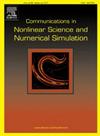A high-order, high-efficiency adaptive time filter algorithm for shale reservoir model based on coupled fluid flow with porous media flow
IF 3.4
2区 数学
Q1 MATHEMATICS, APPLIED
Communications in Nonlinear Science and Numerical Simulation
Pub Date : 2025-03-19
DOI:10.1016/j.cnsns.2025.108771
引用次数: 0
Abstract
In this paper, a third-order time adaptive algorithm with less computation, low complexity is provided for shale reservoir model based on coupled fluid flow with porous media flow. This algorithm combines a method of three-step linear time filters for simple post-processing and a second-order backward differential formula (BDF2), is third-order accurate in time, and provides no extra computational complexity. At the same time, the time filter method can also be used to damp non-physical oscillations inherent in the BDF2 method, ensuring stability. We prove the algorithm’s stability of the constant stepsize second-order backward differential formula plus time filter (BDF2-TF) and the third-order convergence properties of the fluid velocity and hydraulic head in the norm. In numerical experiments, this adaptive algorithm automatically adjusts a time step in response to the varying characteristics of different models, ensuring that errors are maintained within acceptable limits. The algorithm addresses the issue that high-order algorithms may select inappropriate time steps, resulting in instability or reduced accuracy of a numerical solution, and thereby it enhances calculation accuracy and efficiency. We perform three-dimensional numerical tests to examine the BDF2-TF algorithm’s effectiveness, stability, and third-order convergence. Simultaneously, a simplified model is employed to simulate the process of shale oil extraction from reservoirs, further demonstrating the algorithm’s practical applicability.
基于流体-多孔介质耦合渗流的页岩储层模型高阶高效自适应时间滤波算法
本文提出了一种计算量少、复杂度低的三阶时间自适应流体与多孔介质耦合渗流页岩储层模型求解算法。该算法结合了用于简单后处理的三步线性时间滤波方法和二阶后向微分公式(BDF2),在时间上具有三阶精度,并且不提供额外的计算复杂度。同时,时间滤波方法还可以用来抑制BDF2方法固有的非物理振荡,保证稳定性。证明了常步长二阶后向微分公式加时间滤波器(BDF2-TF)算法的稳定性,以及流体速度u和水头φ在L2范数中的三阶收敛性。在数值实验中,该自适应算法根据不同模型的不同特征自动调整时间步长,确保误差保持在可接受的范围内。该算法解决了高阶算法可能选择不合适的时间步长导致数值解不稳定或精度降低的问题,从而提高了计算精度和效率。我们进行三维数值测试来检验BDF2-TF算法的有效性、稳定性和三阶收敛性。同时,采用简化模型对储层页岩油采出过程进行了模拟,进一步验证了算法的实用性。
本文章由计算机程序翻译,如有差异,请以英文原文为准。
求助全文
约1分钟内获得全文
求助全文
来源期刊

Communications in Nonlinear Science and Numerical Simulation
MATHEMATICS, APPLIED-MATHEMATICS, INTERDISCIPLINARY APPLICATIONS
CiteScore
6.80
自引率
7.70%
发文量
378
审稿时长
78 days
期刊介绍:
The journal publishes original research findings on experimental observation, mathematical modeling, theoretical analysis and numerical simulation, for more accurate description, better prediction or novel application, of nonlinear phenomena in science and engineering. It offers a venue for researchers to make rapid exchange of ideas and techniques in nonlinear science and complexity.
The submission of manuscripts with cross-disciplinary approaches in nonlinear science and complexity is particularly encouraged.
Topics of interest:
Nonlinear differential or delay equations, Lie group analysis and asymptotic methods, Discontinuous systems, Fractals, Fractional calculus and dynamics, Nonlinear effects in quantum mechanics, Nonlinear stochastic processes, Experimental nonlinear science, Time-series and signal analysis, Computational methods and simulations in nonlinear science and engineering, Control of dynamical systems, Synchronization, Lyapunov analysis, High-dimensional chaos and turbulence, Chaos in Hamiltonian systems, Integrable systems and solitons, Collective behavior in many-body systems, Biological physics and networks, Nonlinear mechanical systems, Complex systems and complexity.
No length limitation for contributions is set, but only concisely written manuscripts are published. Brief papers are published on the basis of Rapid Communications. Discussions of previously published papers are welcome.
 求助内容:
求助内容: 应助结果提醒方式:
应助结果提醒方式:


